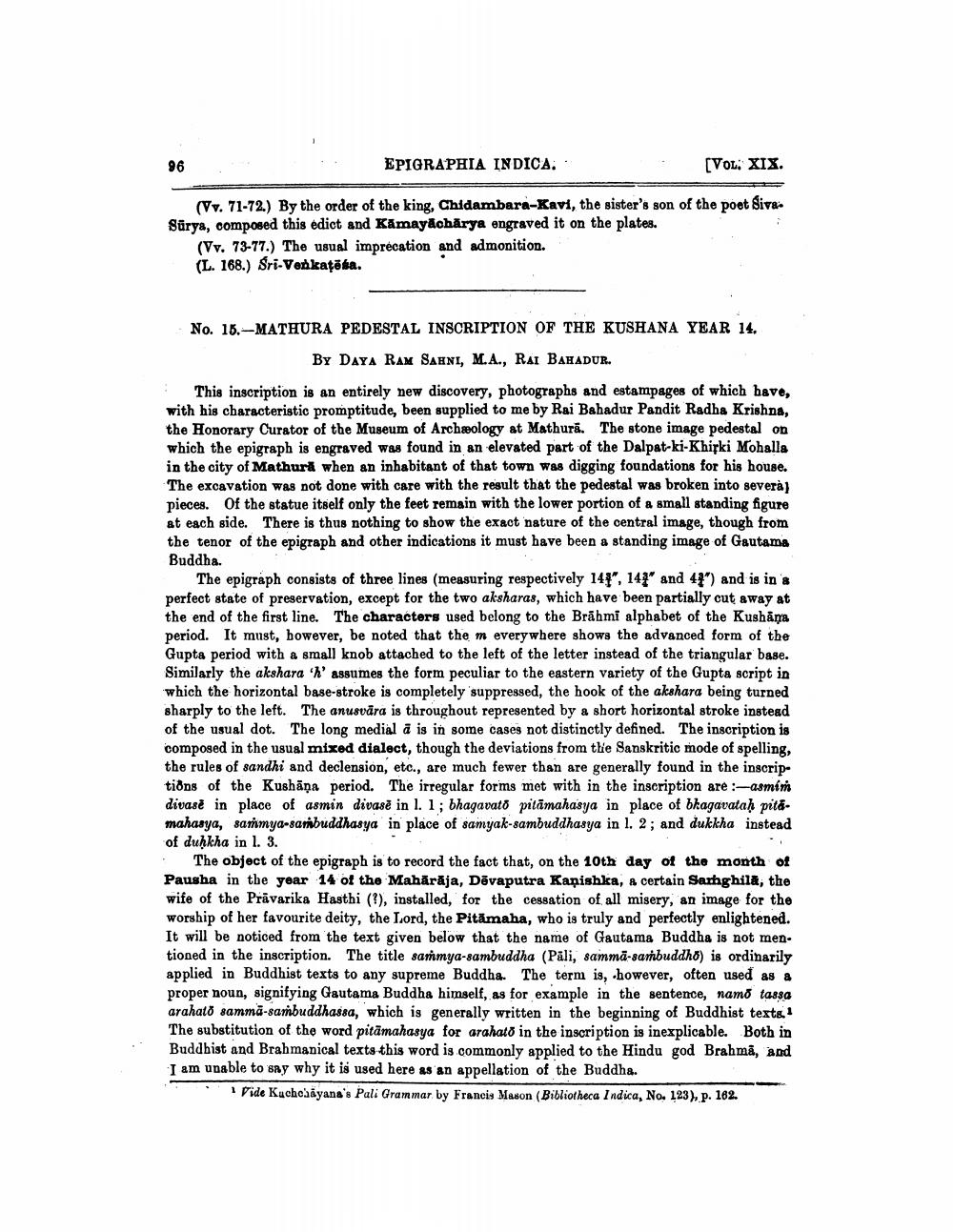________________
EPIGRAPHIA INDICA,
(VOL. XIX.
(Vv. 71-72.) By the order of the king, Chidambara-Kavi, the sister's son of the poet SivaSürya, composed this edict and Kamayacharya engraved it on the plates.
(Vv. 73-77.) The usual imprecation and admonition. (L. 168.) Sri-Venkatēta.
No. 16.-MATHURA PEDESTAL INSCRIPTION OF THE KUSHANA YEAR 14.
BY DAYA RAM SAHNI, M.A., Rai BAHADUR. This inscription is an entirely new discovery, photographs and estampages of which have, with his characteristic promptitude, been supplied to me by Rai Bahadur Pandit Radha Krishna, the Honorary Curator of the Museum of Archæology at Mathurā. The stone image pedestal on which the epigraph is engraved was found in an elevated part of the Dalpat-ki-Khipki Mohalla in the city of Mathurd when an inhabitant of that town was digging foundations for his house. The excavation was not done with care with the result that the pedestal was broken into severa) pieces. Of the statue itself only the feet remain with the lower portion of a small standing figure at each side. There is thus nothing to show the exact nature of the central image, though from the tenor of the epigraph and other indications it must have been a standing image of Gautama Buddha.
The epigraph consists of three lines (measuring respectively 149", 147" and 44") and is in & perfect state of preservation, except for the two aksharas, which have been partially cut away at the end of the first line. The characters used belong to the Brāhmi alphabet of the Kushāņa period. It must, bowever, be noted that the m everywhere shows the advanced form of the Gupta period with a small knob attached to the left of the letter instead of the triangular base. Similarly the akshara 'l' assumes the form peculiar to the eastern variety of the Gupta script in which the horizontal base-stroke is completely suppressed, the hook of the akshara being turned sharply to the left. The anusvāra is throughout represented by a short horizontal stroke instead of the usual dot. The long medial à is in some cases not distinctly defined. The inscription is composed in the usual mixed dialect, though the deviations from the Sanskritic mode of spelling, the rules of sandhi and declension, etc., are much fewer than are generally found in the inscriptions of the Kushāna period. The irregular forms met with in the inscription are:-asmin divase in place of asmin divase in l. 1; bhagavató pitämahasya in place of bhagavataḥ pitamahasya, saṁmya-sambuddhasya in place of samyak-sambuddhasya in l. 2; and dukkha instead of duḥkha in l. 3. • The object of the epigraph is to record the fact that, on the 10th day of the month of Pausha in the year 14 of the Mahārāja, Dēvaputra Kanishka, a certain Sarhghila, the wife of the Prävarika Hasthi (), installed, for the cessation of all misery, an image for the worship of her favourite deity, the Lord, the Pitămaha, who is truly and perfectly enlightened. It will be noticed from the text given below that the name of Gautama Buddha is not men. tioned in the inscription. The title saṁmya-sambuddha (Pali, sammā-sambuddho) is ordinarily applied in Buddhist texts to any supreme Buddha. The term is, however, often used as a proper noun, signifying Gautama Buddha himself, as for example in the sentence, namo tassa arahatð samma-sambuddhassa, which is generally written in the beginning of Buddhist texts 1 The substitution of the word pitämahasya for arahato in the inscription is inexplicable. Both in Buddhist and Brahmanical texts this word is commonly applied to the Hindu god Brahmā, and I am unable to say why it is used here as an appellation of the Buddha.
Vide Kuchesāyana's Pali Grammar by Francis Mason (Bibliotheca Indica, No. 123), p. 162.




